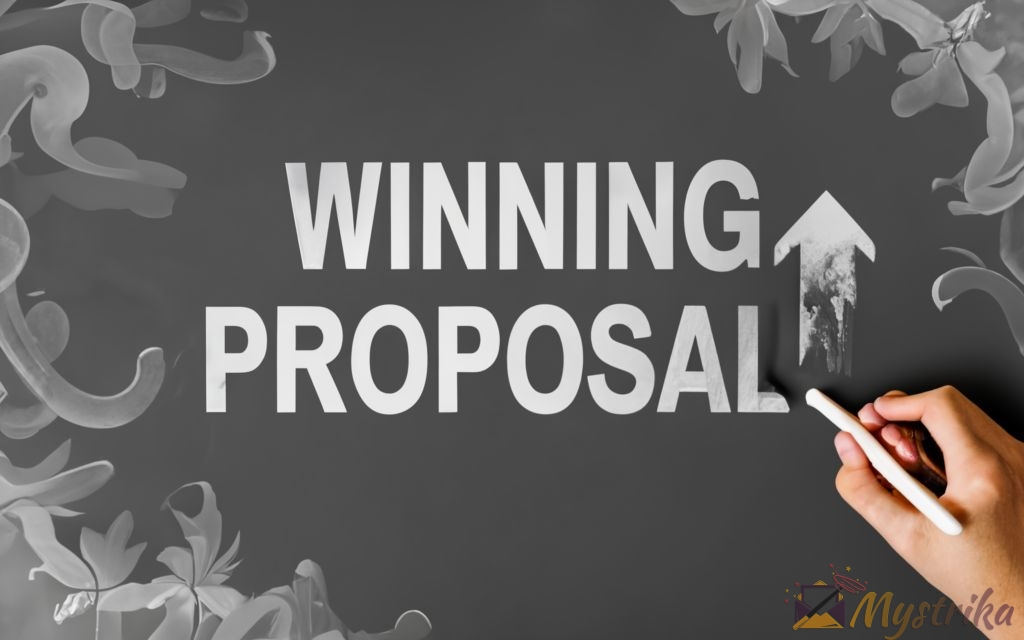They say the pen is mightier than the sword. But it takes skill to wield the pen and craft proposals powerful enough to win business. This guide provides the blueprint to write winning proposals that consistently win deals and convince clients to say YES. Follow these proven best practices to sharpen your proposal writing sword and make your documents impossible to ignore. Read on to learn all the secrets, tactics, templates, and tools to create razor-sharp proposals that cut through the competition. The craft of penning persuasive proposals awaits – let’s get started!
Why Writing a Winning Proposal Matters
When it comes to winning new business, your proposal is one of the most critical factors determining success or failure. An excellent proposal doesn’t just present what you plan to do—it makes a compelling case for why the client should choose you over competitors.
Let’s explore four key reasons why writing a winning proposal gives you the best shot at getting clients to say “yes.”
Get Approval and Funding for Your Project or Service
Imagine you have a stellar idea for a new product, service, or initiative within your company. The only catch? You need approval from decision-makers to get funding and resources to turn your vision into reality.
This is where a well-crafted proposal comes in. Your document needs to convince stakeholders that your idea is worth investing in. Demonstrate a clear understanding of the problem you’ll solve, back up claims with stats and data, and explain step-by-step how you’ll execute the project successfully.
Without a solid proposal, you won’t get buy-in. Let’s say your document is vague or disorganized. It will raise more questions than it answers. The lack of specifics will make evaluators skeptical about your ability to deliver. On the other hand, a focused, well-written proposal proves you’ve done your homework and thought through how to make the idea work.
Some tips to get approval:
- Highlight business impact: Calculate ROI, increased revenue, cost savings, or other financial benefits. Attach projected budget numbers.
- Define what success looks like: Include measurable goals and metrics to track progress.
- Address risks preemptively: Be transparent about potential challenges and your mitigation strategies.
With a convincing proposal, you stand the best chance of getting decision-makers’ green light and resources.
Beat the Competition and Win More Business
Most deals involve multiple vendors competing for the client’s business. How do you make sure your proposal comes out on top? Superior content is critical.
Carefully evaluate what the prospect wants to achieve and show how your solution uniquely meets their needs. Back up your claims with facts, figures, and visuals tailored to the opportunity. Demonstrate a deep understanding of their problems through case studies, testimonials, and industry research.
A generic, one-size-fits-all proposal will fall flat compared to a customized document aligned with the prospect’s goals. Mediocre proposals are easily forgotten but an outstanding one keeps you top of mind.
Make sure you:
- Highlight differentiators: What makes your company, approach, team better than competitors?
- Address pain points: Show how you’ll alleviate key struggles prospects face.
- Use visuals: Charts demonstrating ROI, process flows, product images etc.
With a polished, compelling proposal focused on the prospect’s needs, you’ll edge out competitors and be remembered when decision time comes.
Convince Clients You Understand Their Needs
Prospects want to know you truly “get” them. A proposal is your chance to demonstrate you comprehend their problems, goals, and desired outcomes.
How do you do this? Thorough upfront research and conversations to understand pain points. Reflect these learnings in your proposal using the prospect’s terminology. Summarize the current state versus where they want to be.
For example, an IT services proposal could state:
After interviewing Acme’s developers, it’s clear the outdated server infrastructure frequently crashes and causes costly downtime during peak business hours. Acme wants to modernize their servers to achieve 99.95% uptime.”
This level of understanding builds credibility and trust.
Additional tips for convincing clients you grasp their needs:
- Use their language: Mirror terminology and phrasing stakeholders used.
- Demonstrate attentive listening: Reflect their challenges, objectives, and requirements.
- Ladder up to business outcomes: Connect your solution to strategic goals.
When clients realize you’ve paid close attention and done your homework, they’ll have faith you can deliver.
Prove You Can Deliver Results
At the end of the day, prospects want to know you’ll achieve the desired outcomes. Your proposal must instill confidence you can execute if selected.
How do you prove capability? Several ways:
- Detail your methodology: Walk through how you’ll approach the project step-by-step.
- Leverage case studies: Show examples of past success in similar engagements.
- Highlight credentials: Certifications, awards, client testimonials, experience.
- Include a project plan: Milestones, timelines, deliverables schedule.
The more evidence you provide of successful delivery, the better. Think through what would convince you that a vendor could achieve desired results. Then make sure to include those specifics in the proposal.
Some other tips for proving capability:
- Demonstrate experience with their industry and type of project.
- Introduce the project team and their relevant expertise.
- Share risk mitigation plan to surface potential pitfalls.
Craft your proposal to address the prospect’s #1 question – “Can you get the job done successfully?” Affirm you have the skills, experience, and approach to deliver the outcome they want.
In summary, a winning proposal is essential to get approval, beat competitors, prove understanding of client needs, and instill confidence in your ability to execute successfully. With so much riding on this document, invest significant time perfecting every aspect. Keep polishing until your proposal gets a definitive “yes!”
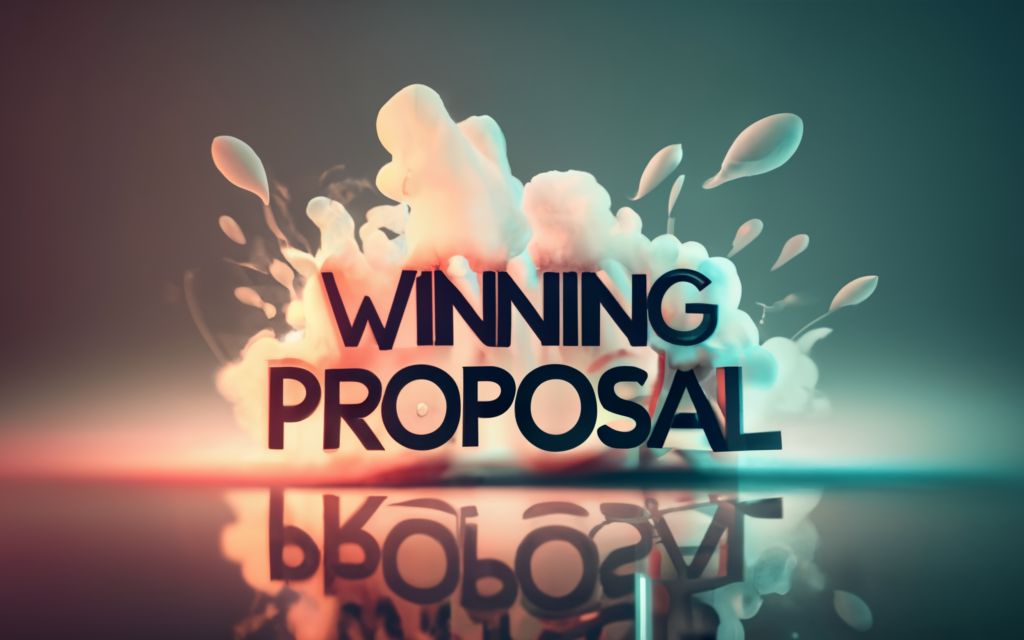
Key Elements of a Winning Proposal
Crafting a proposal that clinches the deal requires including the right components. While each prospect has unique needs, most winning proposals contain these six key elements:
Executive Summary
The executive summary is one of the most critical sections. It appears first and offers a high-level overview of the key points.
Keep it short and compelling. Summarize:
- The problem or opportunity: What challenge will you address?
- Your proposed solution: Overview of product, service, project.
- Client benefits: Quantify the expected ROI, cost savings, increased revenue.
- Proof of capability: Summary of expertise, credentials, past successes.
- Next steps: Explicit call to action and timeline.
The executive summary primes readers on what to expect and gets them excited to dive into the details. It should intrigue them to read further.
Some tips for an engaging executive summary:
- Lead with the strongest value proposition first. Make them want to learn more right away.
- Avoid excessive details or descriptions. Keep it short and impactful.
- Use visuals like charts to illustrate ROI.
- Write it last. You can better summarize after writing the full proposal.
An excellent executive summary generates enthusiasm for your solution and prompts readers to keep exploring the proposal.
Statement of Work and Deliverables
The statement of work (SOW) defines the scope and specifics of what you will deliver. It details the tangible work products, services, or goods you will provide.
For a new software implementation, deliverables may include:
- Installation and configuration
- Integration with existing systems
- User training
- Testing and quality assurance
- Documentation and user manuals
For a consulting engagement, deliverables may be:
- Current state analysis report
- Future state recommendations
- Implementation plan
- Progress reports and presentations
The SOW turns your proposed solution into concrete, measurable deliverables. It also provides milestones for tracking progress. Your deliverables should clearly connect to solving the client’s problem.
In your SOW:
- Break down the work into logical phases and tasks.
- List specific deliverables for each phase in granular detail.
- Include due dates or timelines for deliverables.
- Define responsibilities – what you will provide versus the client.
Project Approach and Methodology
This section describes how you will execute the project to achieve desired outcomes. It demonstrates that you have carefully thought through how to make the engagement a success.
Some elements to cover:
- Process steps: What are the end-to-end stages and associated activities?
- Tools and technologies: What platforms, software, or equipment will you leverage?
- Project management approach: Waterfall, agile, etc. – how will you manage the project lifecycle?
- Resource plan: Team member roles, responsibilities, and levels of effort.
- Governance: How will you communicate progress and manage change requests?
- Risk management: Potential issues, mitigation tactics, and contingency plans.
The project approach section shines light on your procedures and how you will operate day-to-day. It shows attentiveness to the details that matter for smoothly delivering the project.
Illustrate your methodology with diagrams and flowcharts. Outline steps at a reasonable level of detail – too high-level seems vague but extremely granular overwhelms. Demonstrate you have carefully mapped out the execution strategy.
Company Profile and Qualifications
This section provides background on your business and why you are qualified to deliver the solution proposed. It builds credibility that you can achieve the desired outcome.
Areas to cover:
- Company overview: Location, leadership, mission, values, and years in business. Brief history and growth trajectory.
- Relevant experience: Prior projects similar to this one where you achieved success.
- Client list: Logos and names of notable companies you’ve served.
- Case studies: 1-2 detailed examples showcasing your expertise and past performance.
- Testimonials: Quotes from satisfied clients on their experience working with you.
- Awards and certifications: Recognition of your capabilities.
- Team bios: Background, credentials, and expertise of key team members.
Avoid making unsupported claims about your capabilities. Back up profile details with facts, figures, specific examples, and third-party validation. These build confidence in your ability to deliver results.
Pricing and Payment Terms
This critical section provides detailed cost information and payment expectations. The pricing model and structure varies based on the service or product:
- Fixed fee: Single flat rate for the entire project.
- Time and materials: Hourly or daily rates for team members.
- Per phase: Cost associated with each major phase.
- Subscription: Monthly or annual fee, often per user.
- Product/service catalog: Itemized list with costs for each.
- Hybrid model: Combination of fixed fee and variable rate.
Beyond defining the pricing and rates, cover:
- Payment milestones: When payments are due – upfront, after milestones, monthly?
- Payment methods: Options like wire transfer, ACH, check, credit card.
- Discounting: Any volume discounts or special offers?
- Travel expenses: If relevant, how travel costs will be handled.
A detailed breakdown of costs and billing practices prevents surprises down the road. Make sure to define pricing terms aligned with the value you deliver.
Client Benefits and Value Proposition
A compelling proposal reframes the prospect’s challenges in terms of the benefits your solution will provide. This section explains the payoff and ROI they will realize by moving forward.
Focus on the business case and translate how you will:
- Save money through efficiency gains and cost reductions.
- Increase revenue by reaching new markets or building capacity.
- Accelerate speed through process improvements and automation.
- Enhance quality and service through elevated performance.
- Reduce risk thanks to your expertise and methodologies.
Quantify benefits with metrics like:
- Dollars saved or added bottom-line impact.
- Percentage gains in productivity or sales.
- Hours, days, or weeks of time savings.
- Decreased customer churn or increased retention.
Visuals like charts help illustrate the value your solution will unlock. Reinforce that the client’s investment will pay off – and then some.
Bringing It All Together
These six sections form the core components of a winning proposal framework. They provide the details needed to evaluate your offering and make a confident decision. While you can customize the structure to suit each opportunity, including these elements establishes a solid foundation for showcasing the value you bring.
With a compelling executive summary, detailed SOW, pragmatic methodology, company credibility, transparent pricing, and quantified benefits, your proposal will prove to clients you are the right choice.
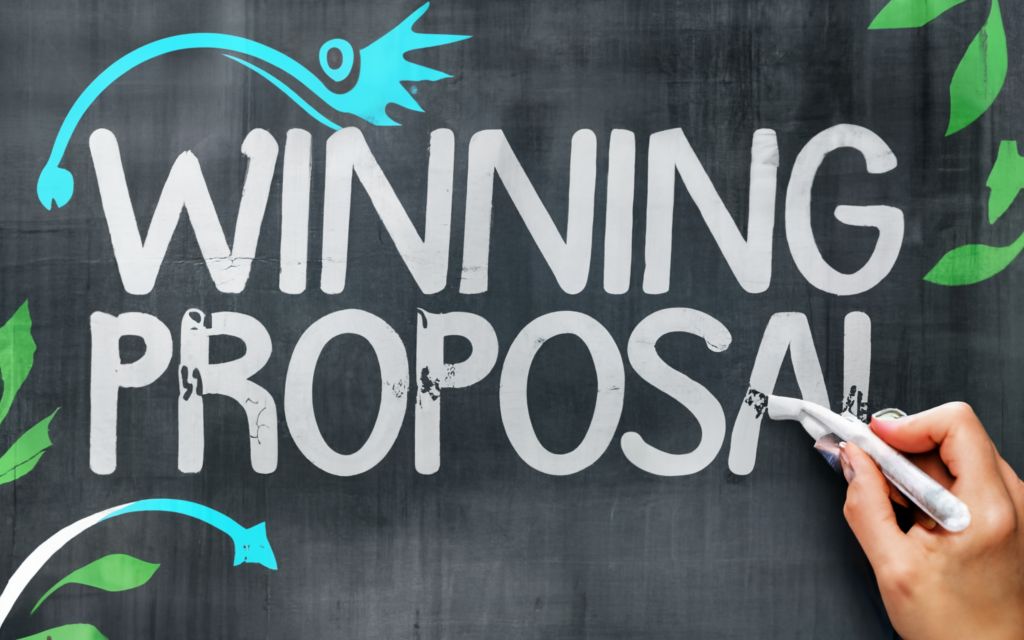
How to Write a Proposal That Wins
Now that we’ve covered the key ingredients, let’s discuss how to blend them into a winning proposal. Follow these proven best practices as you write to boost your chances of success.
Research the Prospect and Opportunity
Thorough research lays the foundation for an effective proposal. Take time upfront to understand the prospect’s organization, industry, challenges, and objectives.
Key areas to research:
- Organization details: Website, executives, locations, press releases, revenue, number of employees.
- Industry research: Trends, competitors, terminology, issues and opportunities.
- RFP document: Carefully review all requirements and scoring criteria.
- Stakeholder profiles: Names, titles, backgrounds and goals of key decision makers.
- Existing systems/processes: What is already in place you may need to integrate with or replace?
- Pain points: Main struggles and challenges stakeholders aim to address.
- Tried solutions: What vendors or remedies have they attempted already without success?
Armed with these insights, you can tailor content to demonstrate you grasp their situation and goals. Include research facts directly in your proposal to showcase your knowledge.
Structure Content Logically
Organization is critical – make sure readers can easily follow the flow of your document. Use section headers and bullet points to segment related chunks of information.
Logical progression to consider:
- Title page: Company name, prospect, project name, and date.
- Executive summary
- About our company: History, credentials, differentiation.
- Diagnosing your needs: Summary of prospect’s goals, challenges, and requirements.
- Our proposed solution: Overview of offering with high-level benefits.
- Project approach: Step-by-step methodology with timeline.
- Statement of work: Detailed deliverables tied to phases.
- Pricing: All cost information and payment expectations.
- Client success stories: Case studies proving capability in similar work.
- Our team: Bios of key team members with relevant experience.
- Next steps: Explicit call to action and due date for decision.
Group related information into neat sections so readers can easily find what they need. Logical organization makes your document scannable.
Use Clear, Concise Language
Avoid complex sentences and industry jargon. Write in simple, straightforward language your prospect will grasp.
- Keep sentences short – around 15-20 words maximum.
- Stick to common words most readers will understand.
- Break up dense paragraphs into bite-sized chunks.
- Use bullet points to summarize key takeaways.
- Include explanatory captions for all visuals and graphs.
- Define acronyms – don’t assume readers know obscure industry terms.
Reading level tools like the Flesch-Kincaid grade level indicator can help assess if your text is consumer-friendly. Aim for grade level 8-10.
Streamlined writing enables readers to absorb your message quickly. Complex language obscures meaning and causes readers to disengage.
Focus on Client Needs and Benefits
Rather than boasting about your capabilities, shift the focus to client outcomes. Structure content around how you will solve their challenges and deliver tangible benefits.
For each section, state needs first before presenting your solution. For example:
- “Acme Corp seeks to reduce IT infrastructure costs by 25%. Our cloud migration offering has lowered costs by an average of 28% for similar clients.”
- “Acme requires a 98% uptime SLA. Our redundancy planning and 24/7 monitoring services deliver 99.99% uptime.”
This “you, you, you, we” structure shows you understand and will satisfy their requirements.
When describing features and services, always tie back to corresponding benefits. For example:
- “Our rapid prototyping process enables iterating on product designs in days rather than weeks, accelerating time-to-market.”
By keeping the focus on the client, your proposal shows you have their best interests in mind.
Provide Specific Details and Data
Back up claims about your capabilities with statistics, facts, and details. These build credibility and assurance you can deliver as promised.
Ways to provide convincing specifics:
- Define methodology: Break down step-by-step what your process looks like.
- Leverage metrics: ROI you drove, efficiency gains, savings – include measurable impact.
- Use timeframes: Speed up development cycles from 6 months to 6 weeks.
- Provide implementation details: Team roles, equipment used, delivery approach.
- Share risk management tactics: Redundancy, backup systems, safety stock for continuity.
- Describe quality control: Testing, inspections, progress reviews.
- Cite research: External data on market size and trends proving demand.
The more precise data you provide, the more confident decision makers will feel in your ability to execute successfully.
Emphasize Your Competitive Advantage
Your proposal must make a compelling case for why you are uniquely qualified versus alternatives. Emphasize differentiators throughout.
For example:
- “Our rapid prototyping process enables iterating on product designs in days rather than weeks, accelerating time-to-market.”
- “Our redundancy planning and 24/7 monitoring services deliver industry-leading uptime of 99.99%.”
- “Our US-based support team achieves a 97% customer satisfaction rating, far exceeding competitors.”
Quantify how you surpass competitors on price, quality, speed, performance, or other metrics. Quote favourable comparisons or rankings against alternatives.
Highlight your secret sauce – proprietary processes, technology, experience – that gives you an edge. Convince readers you offer distinct advantages competitors lack.
Include Testimonials and Case Studies
Social proof builds trust and confidence in your capabilities. Include credible third-party validation like client testimonials and case studies.
Testimonials should quote satisfied customers praising their experience working with you. For example:
- Acme Inc’s proprietary methodology enabled us to achieve a 51% increase in sales pipeline within 6 months. The results exceeded our expectations.” – VP of Sales, XYZ Corporation
Case studies tell a more in-depth story of a client’s challenge, your solution, and the results achieved. Outline how the project parallels what this prospect is trying to accomplish.
When featuring a client example:
- Describe their situation – industry, challenges, goals.
- Explain your process – approach, methodology, tools used.
- Quantify results – metrics achieved, testimonials.
- Connect to prospect’s needs – their situation is analogous.
Social proof builds credibility and reassurance you can achieve similar success.
Make an Explicit Call to Action
Don’t end your proposal without a strong call to action (CTA). Tell readers specifically what you want them to do and when.
Some examples:
- “Please sign and return the attached agreement by DD/MM/YYYY to confirm kickoff of Phase 1.”
- “Let’s schedule a working session on DD/MM/YYYY to review project timelines and finalize details.”
- “We look forward to your team’s feedback and approval by DD/MM/YYYY to move forward.”
- “Please contact us at [email] or [phone] by DD/MM/YYYY if you would like to move to the next step of finalizing contract terms.”
Clearly spell out the action you want readers to take along with a deadline. This creates a sense of urgency. Following up after submitting your proposal is also key – don’t just wait for a response.
Stand out from the competition by mastering these proposal writing best practices. With a polished document focused on client needs, you’ll convince stakeholders to award you the deal.
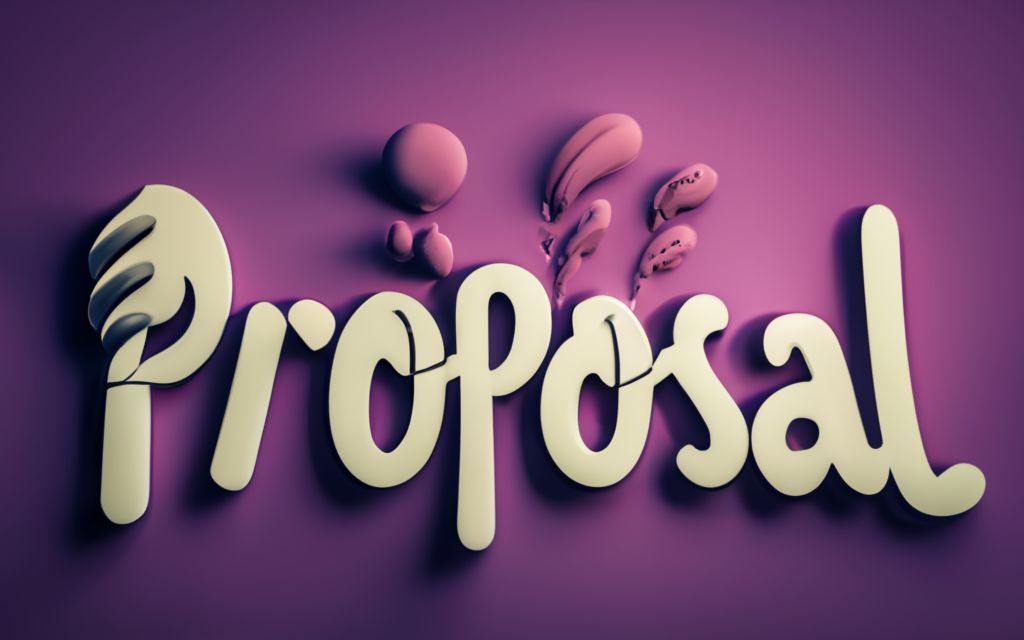
Mistakes to Avoid When Writing Proposals
Even seasoned proposal writers can fall into traps that sabotage their chances of success. Be aware of these common blunders, and avoid making them as you craft your document.
Submitting a Template Without Customization
Many companies rely on pre-built proposal templates to improve efficiency. Templates aren’t inherently bad – they provide helpful pre-written content and consistent formatting.
The problem arises when submitters plug in a client’s name and shoot over a generic template without customization. This swift, thoughtless approach is easy to detect and performs poorly.
Make sure to tailor templates to each prospect’s unique situation. Demonstrate you took time to understand their needs and shaped the proposal accordingly.
Areas to customize:
- Language: Use client’s terminology and reflect their goals. Don’t make them conform to your language.
- Content: Address their specific pain points, requirements, and concerns.
- Pricing: Provide costs aligned to the deal on the table, not your full catalog.
- Page length: Expand or trim content suited to the opportunity size and complexity. Don’t overwhelm them.
- Visuals: Include prospect-specific data in charts and graphs. Generic content won’t resonate.
- Case studies: Feature clients in similar industries the prospect can relate to.
While templates provide helpful boilerplate language, proposals must be adapted and enhanced for each opportunity. Think surgically about what to modify for relevance.
Using Dense, Complex Language
Some writers try to impress readers by filling proposals with convoluted text chock-full of jargon and run-on sentences. This has the opposite effect – readers just get frustrated and confused.
Aim for clarity and brevity instead. As we covered earlier, use plain language readers can easily digest. Break up long blocks of text with headers and bullets.
If including technical terminology is unavoidable, explain concepts simply first. For example:
- “Migration to a cloud-based platform provides greater scalability and uptime. In layman’s terms, cloud hosting allows websites to handle more traffic without crashing and minimizes downtime.
Don’t force readers to stop and decipher complex verbiage – they’ll quickly move on to more readable proposals.
Focusing Too Much on Company Background
Readers mainly care about what you can do for them – not tedious details about your company’s entire history or service catalog. Limit background to a concise company bio and devote more real estate to sections demonstrating client-centricity.
Prioritize content explaining how you will bring value to the prospect’s organization. Cut anything self-promotional that doesn’t directly serve that purpose.
For example, skip details like:
- Lengthy corporate history dating back to the stone ages.
- Countless awards won across all service lines.
- Headshots and full bios of every executive.
Stay laser focused on content that proves you understand the prospect’s needs and how you will deliver ROI – not glory days from your company’s past.
Neglecting to Highlight Deliverables
Surprisingly, some proposals lack adequate specifics on deliverables. But the SOW is vital to prove you have mapped out how to execute the engagement strategically.
Ensure your deliverables section includes:
- Granular deliverables: Break down into individual tangible work products and services.
- Milestones: Major phases deliverables fall within and due dates.
- Metrics/KPIs: Measurable evaluation criteria for acceptance.
- Governance: Process for reviewing and approving deliverables with client.
Don’t make deliverables an afterthought. Given their importance, dedicate ample space to spell out deliverables in detail and tie them back to solving the prospect’s challenges.
Thorough deliverables instill confidence you have carefully considered how to make the project successful. Vague deliverables raise doubt.
Failing to Address Concerns and Objections
Your proposal should preemptively surface potential concerns on readers’ minds. But many writers avoid mentioning risks or downsides to dodge objections.
Bad idea. Savvy prospects will have questions and concerns about your solution. Failing to acknowledge their perspective makes you seem oblivious or deceptive.
Deftly handle objections head-on by:
- Raising potential issues they may be thinking about proactively. Don’t wait for them to surface concerns.
- Demonstrating you understand their apprehension and why they may perceive downsides.
- Explaining how you mitigate risks. Convince them you have solutions to address objections.
Skillfully handled objections build trust and credibility. Ignoring concerns causes suspicion and doubt in your solution.
Forgetting a Call to Action and Next Steps
Neglecting to specify the action you want prospects to take is a missed opportunity. Without direction they may shelve your proposal indefinitely.
Clearly request:
- Signature to move forward.
- A face-to-face meeting or call.
- Submittal of a task order.
- Their feedback and thoughts.
Proactively pursuing communication demonstrates eagerness to finalize the deal. An open-ended conclusion risks proposals languishing in prospect’s inboxes.
Don’t put the ball solely in their court. Give prospects a nudge by explicitly stating the follow-up you want.
Steer clear of these missteps to craft proposals that win. An investment upfront in crafting customized, client-focused content pays major dividends.
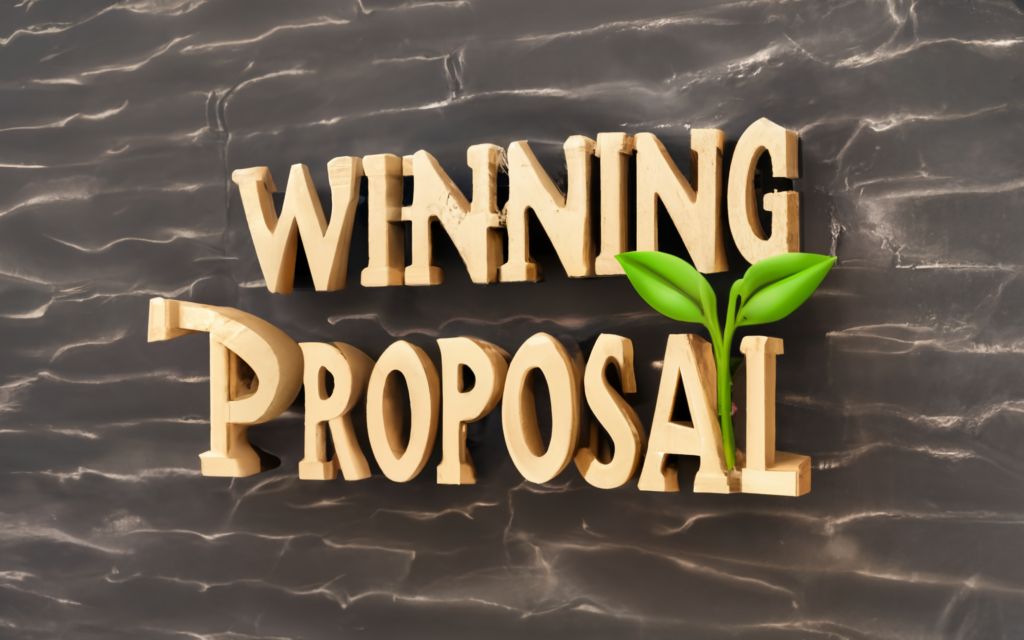
Proposal Writing Tips and Best Practices
Keep these proven techniques in mind to master the art of persuasive proposals:
Align with RFP Requirements
When an RFP document is provided, your proposal must demonstrate point-by-point how you satisfy all requirements outlined. Provide clear, detailed responses to show you meet their criteria.
Create a compliance matrix visually mapping each requirement to your corresponding solution:
| RFP Requirement | Our Solution |
|---|---|
| 99.95% application uptime | Our architecture delivers 99.99% uptime exceeding requirement. |
| Completed in 6 months | Our timeline is 6 months to production release. |
| Support response within 2 hours | Our Platinum SLA guarantees issue resolution in under 2 hours. |
Leave no doubt that you meet or exceed all expectations. Prove it using a compliance matrix, keeping responses concise.
If you know you fall short on certain parameters, acknowledge it transparently. For example:
“While our standard SLA offers next business day response, we offer options to upgrade to premium 24×7 support as required.”
Address any gaps forthrightly rather than ignore areas where you don’t align.
Leverage Visuals Like Charts and Infographics
Visuals make proposals more interesting and drive key data home faster.
Charts simplify communicating:
- Cost/ROI projections
- Processes and workflows
- Timelines and milestones
- Reporting and analytics
- Comparisons to competitors
But don’t just paste in generic clip art. Customize visuals, color palettes, and fonts aligned to your branding. Include explanatory captions so graphics make sense standalone.
Well-chosen images and diagrams reinforce your message visually. Break up dense text with easy-to-digest graphics.
Follow Up After Submitting the Proposal
Don’t submit your proposal into a black box and cross your fingers. Actively follow up to provide additional detail, schedule meetings, and nudge prospects.
Some effective follow-up tactics:
- Call to confirm receipt and assess initial reactions. Offer to answer any questions.
- Schedule a presentation to walk through the proposal in person.
- Send relevant case studies, samples, or work products to reinforce strengths.
- Connect on social media and engage with content to stay top of mind.
- Set up Google alerts on prospect company news and respond when able.
- Follow up with key stakeholders directly via personalized outreach. According to studies, 80% of sales go to the first follow-up. Persistent, value-driven follow-up gives you an advantage to keep momentum going.
Practice Continuous Improvement
Finally, leverage proposals as learning tools. Track:
- Proposal win/loss rates
- Sections prospects engage with most
- Questions and concerns raised
- Reasons for pursuing competitors
Analyze this data to identify areas for improvement in messaging, content structure, visualization, and follow-up.
Additional Tips for Proposal Excellence
- Lead with your strongest value proposition. Hook readers in the first section.
- Quantify benefits whenever possible. attach ROI estimates to claims.
- Make skimming easy with logical formatting and informative headers.
- Check readability level using tools like the Flesch-Kincaid grade level.
- Use active voice and avoid excessive adverbs and filler words.
- Highlight client names and recognizable logos to add credibility.
- Include only information tightly aligned to opportunity. Omit generic filler.
- Use quality paper, binding, and visuals – don’t look amateur.
- Have multiple proofreaders review drafts to catch errors.
- Practice proposing and seek feedback to sharpen skills.
- Research competitors to differentiate yourself favorably.
Mastering proposal writing takes time, but applying these tips will hone your skills with each document. Refining this critical capability pays dividends by winning deals and setting your solutions apart.
Questions to Ask Before Submitting Your Proposal
Before hitting “send,” run through this checklist to catch any areas needing refinement:
Does it clearly convey your value proposition?
- Have you explicitly stated the problem you will solve for the client?
- Did you quantify the expected ROI, cost savings, increased revenue you will drive?
- Are benefits explained in business outcome terms rather than features?
- Is your strongest value proposition highlighted in the executive summary?
- Does the structure make your solution easy to understand quickly?
If the value you bring isn’t abundantly clear in the first few pages, reviewers may not take the time to connect the dots. State your proposition upfront and reinforce benefits throughout to effectively sell them on choosing you.
Is the content organized logically?
- Does the sequence of sections make sense?
- Are related topics grouped into sections with descriptive headers?
- Does the executive summary prepare them for what follows?
- Do section lengths align to importance, with critical areas covered in depth?
- Can a reader easily skim and find what they need?
Logical structure, whitespace, and visual formatting make your document scannable. Reviewers should be able to quickly locate key details. Ensure content flows in an intuitive order.
Does it use simple, straightforward language?
- Is the writing free of complex jargon and technical terms?
- Are sentences relatively short and straightforward?
- Have you defined any industry acronyms or technical concepts?
- Could someone outside your field understand everything?
- Is the tone conversational and audience-focused?
Obtuse language and dense paragraphs cause readers to disengage. Use readability tools to analyze clarity. Simplify any convoluted passages reviewers may need to re-read several times.
Are client needs and benefits emphasized?
- Did you highlight prospect’s pain points and requirements upfront?
- Is your solution framed around addressing their needs?
- Are benefits explained from the client’s perspective?
- Does each capability map directly to an identified requirement?
- Have you quantified improvements relevant to their goals?
Avoid generic, self-promotional content about your offerings. Tailor messaging specifically around how you will further the prospect’s objectives. Keep the focus squarely on them.
Does it highlight your competitive strengths?
- Did you provide specifics on how you surpass competitors?
- Do you quantify how you outperform on price, quality, delivery, service?
- Are your differentiators called out?
- Is proprietary methodology explained that others lack?
- Are favorable comparisons and rankings referenced?
Don’t make bland assertions of superiority. Back up claims with metrics demonstrating you offer distinct advantages competitors cannot match.
Does it address client concerns preemptively?
- Are potential red flags or objections raised directly?
- Do you validate you understand their reservations about your solution?
- Did you explain how risks are mitigated?
- Does it avoid seeming evasive or glossing over downsides?
- Does transparency build trust?
Shining light on concerns upfront shows attentiveness and credibility. Avoid seeming oblivious to risks in their eyes. Handle objections skillfully to turn them into selling points.
Does it include a clear call to action?
- Did you specify exact next steps for the prospect?
- Is there a due date and sense of urgency to act?
- Does the CTA encourage them to contact you with questions?
- Is contact info clearly provided?
- Have you planned active follow-up if they don’t respond?
Don’t end your proposal at the conclusion with no direction on what you want the prospect to do. Give them a compelling nudge to take action and avoid going stale.
Additional Questions to Assess Effectiveness:
- Is it tailored to the prospect with ample customization?
- Are client logos, names, and terminology incorporated?
- Does it demonstrate deep understanding of their needs from research?
- Is proof like case studies, testimonials, and credentials leveraged?
- Are visuals included and well-explained?
- Is pricing broken down in detail with payment expectations set?
- Are next steps and timeline realistic for the prospect?
- Is the length appropriate without unnecessary filler?
- Have you quantified improvements and ROI for each capability?
- Are potential risks and mitigations addressed preemptively?
- Does formatting make skimming easy?
- Is writing professional but accessible with reasonable density?
- Has it been proofread for errors, consistency, and clarity?
- Is it visually appealing with images, whitespace, and our branding?
Don’t leave any stone unturned. Read your proposal imagining you are the client and look to punch holes. Refine continuously until the document effectively proves you are the best choice.
With meticulous attention to each of these success factors, your proposals will demonstrate air-tight value to prospects. Follow this comprehensive checklist, and you’ll submit compelling documents that win.
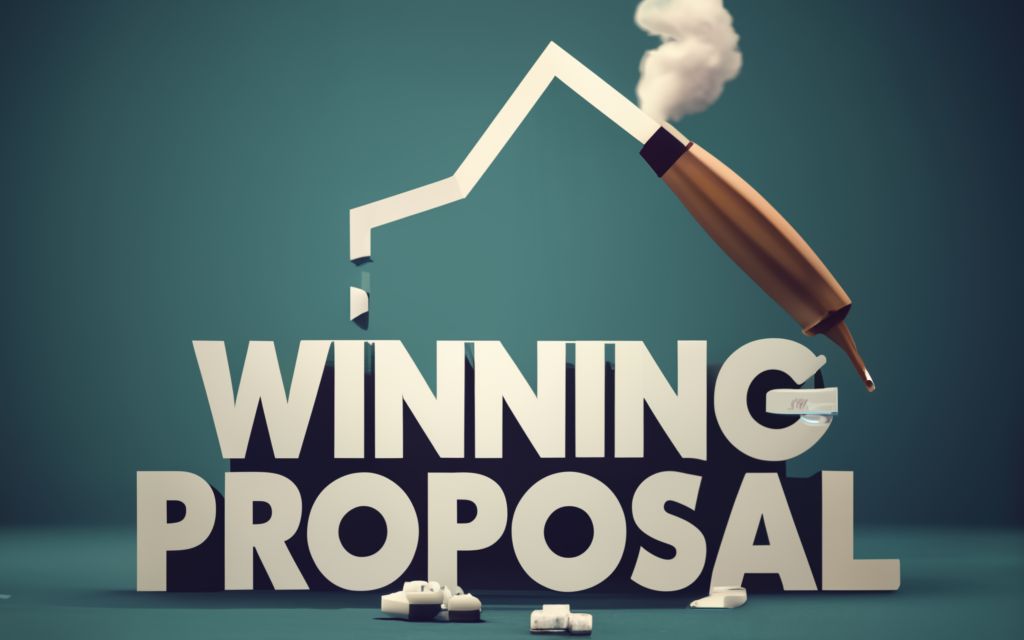
Key Takeaways
Writing winning proposals is a crucial skill for securing new business. Keep these lessons in mind:
- Demonstrate understanding of the client’s needs. Research thoroughly and reflect their goals, challenges, and terminology in your proposal.
- Quantify your value proposition. Include measurable ROI, cost savings, increased revenue, decreased risk – prove your solution delivers concrete business benefits.
- Customize using precise details. Avoid generic templates and include data, visuals, and messaging tailored specifically to the prospect.
- Highlight competitive differentiators. Spell out how your proprietary methodology, experience, team, or technology gives you a unique edge.
- Emphasize deliverables. Provide granular descriptions of the tangible work products and services you will deliver with timeframes.
- Pre-empt concerns. Surface potential issues proactively and explain how you address risks. Don’t avoid acknowledging objections.
- Use clear, concise language. Write in a conversational tone with short sentences and avoid technical jargon. Make the document readable and accessible.
- Include social proof. Client testimonials, case studies, awards, and certifications build credibility and trust.
- Specify clear next steps. Close with an explicit call to action and due date for the prospect to make a decision. Follow up persistently.
- Continuously improve. Analyze past proposals to identify areas for refinement, and implement lessons learned on future proposals.
Master these best practices to craft air-tight proposals that showcase your fit, build confidence, and win more business.
Frequently Asked Questions
Q: How long should a proposal be?
A: Proposals should be as long as needed to communicate your solution, but not unnecessarily long. Think surgically about what content is critical. Complex projects may require 10+ pages whereas a 2-3 page proposal can be sufficient for a simple scope of work.
Q: When should I send a proposal?
A: Send a proposal when prospects request one to move forward with purchasing your solution. You can also proactively provide proposals to introduce your services, but don’t prematurely send proposals to bottom-of-funnel prospects who haven’t expressed interest.
Q: How much detail should I include on pricing?
A: Be as specific as possible on pricing, costs structures, and payment terms so there are no surprises later. Some prospects want pricing upfront in the proposal whereas others may prefer to discuss after initial buyer-seller conversations.
Q: Should I address risks and objections?
A: Yes, you should acknowledge risks and preemptively address concerns the client is likely to have. Handling objections builds credibility vs. seeming evasive. Reassure them you have solutions to mitigate potential downsides.
Q: How do I make proposals visually appealing?
A: Use photos, illustrations, graphs, diagrams, and ample whitespace to make your document aesthetically pleasing and easy to digest. Align visuals to your branding.
Q: What makes a strong call to action (CTA)?
A: An effective CTA clearly specifies the action the prospect should take by a defined deadline. For example, “Please sign this proposal by MM/DD/YYYY to move forward with next steps.” Add urgency and follow up.
Q: Should I list all of my company’s services?
A: No. Only include capabilities directly relevant to the prospect’s needs. Don’t distract with unnecessary details about service lines not on the table. Keep the focus tight.
Q: How do I highlight competitive advantage?
A: Quantify how you outperform competitors on price, quality, speed, service, technology. Quote favorable comparisons and reference achievements competitors cannot match.
Q: What makes a proposal writer successful?
A: Curiosity, business acumen, communication skills, solution-focused thinking, and continuous improvement mindset. Really understanding customer needs is key. The best listen far more than they talk.

